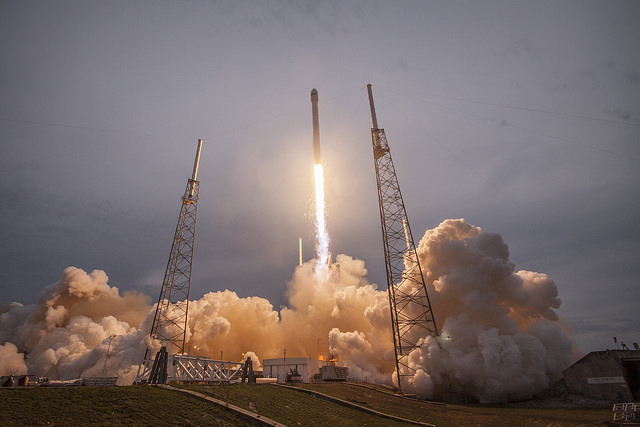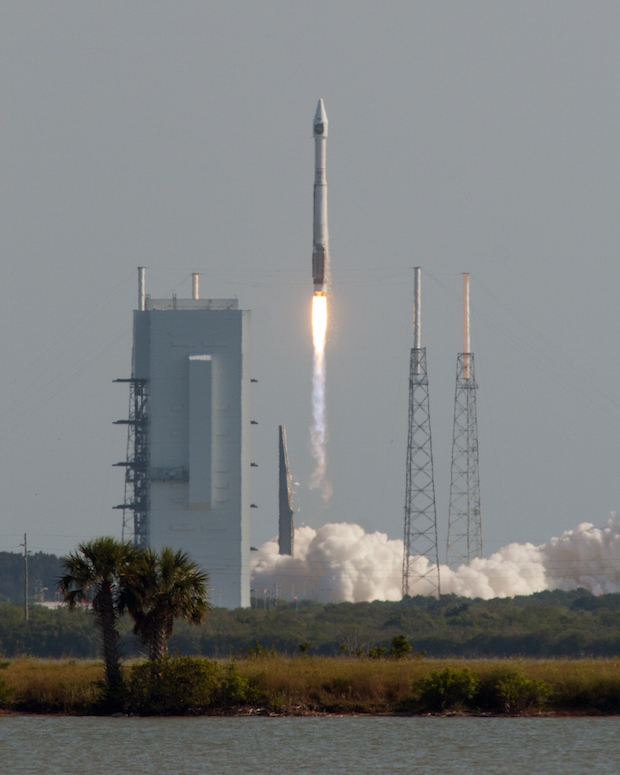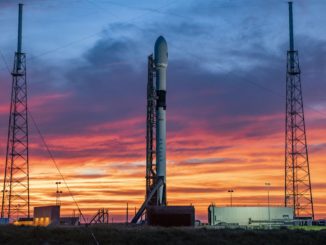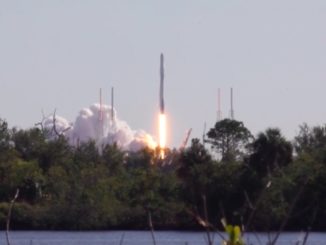
The U.S. Air Force has identified the launch of a next-generation GPS navigation satellite for the first in a series of competitive rocket procurements between United Launch Alliance and SpaceX, service officials announced Wednesday.
The Air Force released a draft request for proposals Wednesday for the launch a GPS 3 navigation satellite. An Air Force spokesperson said a specific spacecraft was not associated with the draft solicitation, which is designed to gauge industry interest and is the first step in a competition expected to last several months.
SpaceX’s Falcon 9 rocket is on track to be certified to launch the Air Force’s most critical class of payloads in June, giving the company the right to win contracts that exclusively went to rival United Launch Alliance since its formation with the merger of Boeing and Lockheed Martin’s rocket divisions in 2006.
The GPS 3 launch competition is the first of nine launch opportunities the Pentagon plans to open for bids through 2017.
Two of the competitions between SpaceX and ULA are scheduled for this year, followed by seven open procurements in fiscal years 2016 and 2017, according to Air Force Secretary Deborah James, who testified before the Senate Armed Services Committee on April 29.
Another 25 launches of military communications, navigation, early warning and spy satellites will be competed from 2018 through 2022, she said.
ULA’s Atlas 5 and Delta 4 rockets were developed under the Air Force’s Evolved Expendable Launch Vehicle program in the 1990s. After initially flying with commercial satellite payloads, the Atlas 5 and Delta 4 have primarily launched military spacecraft over the last decade, receiving all of the Air Force’s EELV launch contracts.
The first three next-generation GPS 3 satellites will be launched by ULA — two on the Delta 4 rocket and one on an Atlas 5. Lockheed Martin is building at least eight of the new-model GPS satellites, which are due to begin launching in 2017 to replace aging GPS 2-series platforms and modernize the military-run navigation network.
The Air Force awarded ULA a $11 billion sole-source contract last year for 36 rocket cores — hardware to cover 28 launches. Air Force and ULA officials said the one-time “block buy” purchase of rocket hardware gave the military $4.4 billion in savings from earlier budget estimates.

Air Force leaders plan to introduce competition to the national security launch program with the nine missions up for bids through 2017, which will be up for grabs by either ULA or SpaceX. The bulk of the launches in the period are earmarked to ULA under the terms of the block buy.
Then the Air Force will open bidding for all military launches starting in 2018, James said.
SpaceX says it can launch the satellites for the Defense Department and the National Reconnaissance Office at less cost than ULA. The Air Force began a series of engineering and financial reviews in 2013 to certify the Falcon 9 rocket to join ULA’s Atlas 5 and Delta 4 in the Pentagon’s stable of launch vehicles.
The Air Force ended competition for its EELV-class missions when the Pentagon approved the Boeing and Lockheed Martin consolidation in 2006, a decision ULA and military officials said was necessary to ensure the survival of the Atlas and Delta rocket families to launch U.S. national security satellites.
Pentagon officials say the Air Force needs two independent launchers to ensure crucial payloads can get to space even if one of the rockets is grounded.
“This is our first competition for EELV launch services in over a decade,” said Lt. Gen. Sam Greaves, the Air Force’s program executive officer for space. “Our intent is to re-introduce competition while maintaining our focus on mission success in support of National Security Space launches.”
The Air Force missed a self-imposed deadline to complete the Falcon 9’s certification reviews by the end of 2014, but officials say SpaceX’s rocket is on schedule to receive the military’s seal of approval in June.
Air Force and SpaceX officials have modified a framework agreement governing the review process, a change the Air Force says will expedite the Falcon 9’s final certification to launch national security satellites.
The agreement’s updated language allows the Air Force to certify SpaceX before the parties finish all of the milestones in the original accord. The agreement signed in June 2013 specified that SpaceX’s upgraded Falcon 9 v1.1 complete three successful launches — a requirement SpaceX achieved in January 2014 — and established reviews of the company’s mission assurance, risk management, and systems engineering processes.

While the Falcon 9 v1.1 has now flown 13 times — all successfully — the Air Force says some of the reviews are not complete.
The Air Force said in a statement that it will grant certification to the Falcon 9 rocket based on SpaceX’s “demonstrated capability to design, produce, qualify, and deliver their launch system.”
“Among other things, these changes allow SpaceX certification with some open work,” the Air Force’s Space and Missile Systems Center said in a statement released May 7.
The Air Force said it will need “jointly approved handling plans” from SpaceX to support tight timelines preparing for launches of national security satellites.
“SpaceX welcomes these actions,” said Gwynne Shotwell, SpaceX’s president and chief operating officer, in the Air Force’s May 7 statement. “We look forward to completing the certification process and competing for EELV missions.”
Gen. John Hyten, head of Air Force Space Command, told lawmakers April 29 that the Falcon 9 rocket can lift about one-third of the military’s national security payloads.
SpaceX’s larger Falcon Heavy rocket, made of three Falcon 9 rocket cores bolted together, is set for its debut test launch late this year. Once it is certified by the Air Force, the Falcon Heavy will give SpaceX access to larger payloads outside the Falcon 9’s range.
Air Force officials said SpaceX submitted a letter to the service in April signaling the company’s intent to certify the Falcon Heavy, outlining a plan to achieve certification after three successful flights of the behemoth rocket.
“Certification of the Falcon Heavy will give SpaceX the capability to lift the majority, if not all, of our projected manifest in the future, and their statement of intent marks the beginning of that certification process,” Air Force Secretary James said April 29. “Make no mistake, our national security for the United States will be far better off the day that we certify SpaceX, and we are shoulder-to-shoulder with them to make sure that we get this done.”
The Falcon Heavy already has one Air Force mission on its books in May 2016 with a hoard of small military research satellites, but the Air Force does not require certification for that mission. The military awarded the launch deal to SpaceX under a contract designed for high-risk, experimental missions.
With SpaceX’s entrance into the Air Force launch market, ULA plans to retire the single-core medium-class variant of the Delta 4 rocket by the end of the decade.
ULA says it hopes to continue flying the Atlas 5 rocket — which is less expensive than the Delta 4 — to compete with SpaceX, giving the Air Force two launch options. The rocket-maker last month unveiled the Vulcan rocket, a replacement for the Atlas 5 and Delta 4, aiming for an initial test flight in 2019.
“We see the opportunity for the SpaceX Falcon 9 to compete head-to-head with the ULA Atlas launch system from both a technical capability, as well as a price, standpoint,” James told Senate lawmakers.
But ULA’s plans require an act of Congress to ease restrictions on the military’s use of Russian-made RD-180 rocket engines, which power the first stage of the Atlas 5 booster. The National Defense Authorization Act of 2015 passed into law in December requires the Air Force stop using Russian engines to launch national security payloads, but exempts some engines already purchased or on contract.
Congress inserted the restrictions on Russian rocket engines after Russia’s annexation of Crimea amid worries that the supply of RD-180 engines could be blocked by the Russian government.
Pentagon lawyers say the engine clause has an unintended consequence and will limit the number of RD-180 engines ULA has in its inventory to loft military satellites below the number originally anticipated when lawmakers wrote the bill. Defense Department officials say the law, as written, gives the Boeing-Lockheed Martin joint venture the ability to compete for just five of the 34 launch procurements planned through 2022.
Some congressional leaders agree with the Pentagon that the restrictions are too onerous and could force the launch market into a reversal of the monopoly enjoyed by ULA since 2006, where SpaceX would win the lion’s share of contracts by default until the Air Force deems the new all-American Vulcan rocket ready for national security launches.
Air Force certification of the Vulcan rocket is not expected before 2022, assuming the launcher’s first flight stays on track for 2019.
Without an adjustment to the defense authorization act, James said the Air Force “would not have real and full competition until a replacement for the Atlas 5 is available.”
If Congress changes the law barring the RD-180 engine, up to 18 of the Russian-made power plants already purchased by ULA could be available for the Atlas 5 to compete for the 34 launch opportunities through 2022.
“If adopted, this proposal would allow us the flexibility to keep the cost-competitive Atlas in play until we have this fully developed domestic alternative,” James said.
Email the author.
Follow Stephen Clark on Twitter: @StephenClark1.



